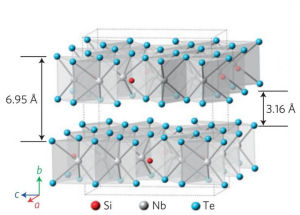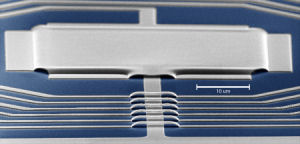
Scientists from the Moscow Institute Of Physics And Technology and Tulane University (New Orleans) have for the first time described the behavior of electrons in a previously unstudied analogue of graphene, two-dimensional niobium telluride, and, in the process, uncovered the nature of two-dimensionality effects on conducting properties. Their findings will help pave the way for the creation of novel flat and flexible electronic devices.
So-called two-dimensional materials like grapheme are a hot research area. The properties of such materials, which can be described as “sheets” with a thickness of a few atoms, strongly differ from their three-dimensional cousins. For example, graphene is transparent, conducts current better than copper and has good thermal conductivity. Scientists suspect that other types of two-dimensional materials may possess even more exotic properties.
One such material is Nb3SiTe6, a compound of niobium telluride. The crystals resemble sandwiches with a thickness of three atoms (around 4 angstroms): a layer of tellurium, a layer of niobium mixed with silicon atoms and then another layer of tellurium. This substance belongs to a class of materials known as dichalcogenides, which may offer two-dimensional semiconducting properties.
In the new research, the scientists synthesized Nb3SiTe6 crystals in a laboratory at Tulane University. They then separated them into two-dimensional layers, taking samples for further analysis by transmission electron microscopy, X-ray crystal analysis and other methods. The goal was to investigate electron-phonon interaction changes.
Phonons are quasi-particles, perhaps better described as quanta of crystal lattice oscillations. Physicists introduced the concept of phonons because it helped simplify the description of processes in crystals, and tracking of electron-phonon interaction is fundamentally important for description of the different conducting properties in matter.
“We developed a theory that predicts that electron-phonon interaction is suppressed due to dimensional effects in two-dimensional material. In other words, these materials obstruct the flow of electrons to a lesser extent,” says Pavel Sorokin, a co-author of the study.
American colleagues confirmed this prediction in related experiments. “They conducted measurements where the same effect was observed. Our calculations allowed the ruling out of other explanations; we managed to prove that changes in electron-phonon interaction occur specifically because of the two-dimensionality of the membrane,” Sorokin adds.
Related:
Discuss this article in our forum
New experimental findings challenge theory of electromagnetism
Spinning nanoparticles hint at origin of life


















Comments are closed.